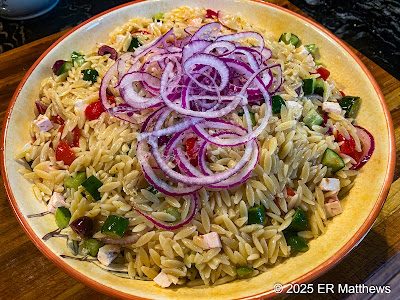Surprise! Our friend Dimitri texted out of the blue on Monday that he and his friend Joe would be in Bend for the weekend. Dimitri still lives in Northern Virginia just outside of DC, so he was not on our bingo card for weekend visitors. He and Joe, a friend currently from Virginia but from Portland in the past, were flying into PDX. After visiting Oregon wine country and exploring Portland, they would be driving to Bend for a long weekend.
 |
| Mediterranean Crew: Greek, Italian, Italian |
Dimitri and Joe had plans to dine out on Saturday at the same time we were at the Trevor Noah show at the amphitheater, so we set a get-together for Sunday starting with pre-game at Viaggio Wine Bar. We met them there after they returned from a day trip to Crater Lake, which if you have never seen before like Dimitri, I guess you have to see. But honestly, battling buses of tourists is not my thing and I would have preferred to visit Paulina Lake instead.
Dimitri and Joe are fellow winos, so we thought that a visit to Viaggio would be welcome. There, they could drool over the curated selection of bottles on the shelves and Coravin selections on the glass list. Where else can you find shelves full of Wachau and Kamptal Riesling, Piemonte wines of all sorts, or Rhônes for days? Maybe in large cities, but in the small city of Bend three hours in any direction from civilization, the selection at Viaggio is miraculous.
After a bottle of Pibarnon Bandol rosé, we drove to the house where all I had to do was assemble dinner. In planning dinner, I wanted something that I could put on the table with little to no effort. Gone are the days of à la minute cooking where cooking is the focus rather than our guests. Hence our menu of chips and salsa verde, enchiladas de carne adovada, and posole amarillo with bacon, corn, and green chiles. Ann made another summer berry and brioche pudding and I had plenty of
lemon-thyme sorbet base in the fridge ready to go into the freezer.
How I arrived at this menu is anyone's guess. I was definitely looking for a slow-cooker meal that would not involve a lot of active cooking on my part. Probably in the back of my mind was the kilo of Chimayo chile that I scored in New Mexico in December. And then, I found some really good looking pork shoulder at the store. Also, who does not like enchiladas? Chips and salsa as well as posole are natural companions to carne adovada, so that part of the menu should not be a surprise.
Before we get into dinner however, Dimitri came bearing a gift, a 2014 Glen Manor Petit Verdot. I texted Jeff, "A friend showed up with a bottle of this," to which he replied, "Keep that friend!" I remember this wine. I believe I did a pairing for it for a barrel tasting. I could be wrong; 2015 was a hot minute ago.
 |
| Dimitri Brought Us a Gift |
 |
| Chips and Charred Jalapeño Salsa Verde |
My usual salsa verde is tomatillos (large can, drained), cilantro (one bunch), garlic (4 cloves), and a serrano chile. When I am lazy, I used canned tomatillos rather than roasting fresh ones. I am often lazy these days. I wanted to change it up a bit with some smokiness, so I charred two jalapeños and used them instead of the serrano. I also threw in an avocado and a pinch of smoked paprika for added smoke.
It was good, but next time, I want it smokier. Maybe I try using a charred poblano. Definitely will char fresh tomatillos on the next iteration. It will be a fun experiment. A batch of salsa verde or chimichurri is usually in our refrigerator: we eat a lot of vegetarian and fish tacos that benefit from salsa.
Saturday, I made a batch of slow cooker carne adovada. Like most dishes, I used no recipe for this super simple stew. I started by cutting the pork shoulder into large cubes, then browning one side of the cubes, followed by transferring them to the slow cooker as each batch browned. I want the flavor that browning creates, but I find that browning all sides of the meat tends to contribute to dryness. Browning one large side of the pork chunks suffices to yield both flavor and succulence.
After the meat was all browned, I added a diced onion to the pork pan along with call it a dozen minced cloves of garlic. Once the onions cooked, I added a a bit of Mexican oregano, rubbed between my palms into a powder, a lot of spicy ground Chimayo chile, and a lesser amount of ancho powder to add some balance to the Chimayo chile. The chile was probably a cup in total, 3/4 Chimayo and 1/4 ancho. After stirring this into the onions well, I added perhaps a couple cups of water, a splash of Sherry vinegar, and a small amount, perhaps a tablespoon, of agave nectar. Once this sauce came together, I poured it over the pork, stirred well, and put the slow cooker on.
I believe that adovada must have acidity; your grandmother may disagree as is her right. Not a lot of acidity, but some. So I always put a bit of vinegar in mine (as I do my Mexican-style chorizo). I also think that spicy Chimayo chile needs just a hint (below the taste threshold) of sweet to help mellow it, hence the agave.
When the pork was cooked, some six or seven hours later, I separated the liquid from the pork. I separated the meat and the cooking liquid for several reasons. With the liquid chilled, I could peel off the layer of pork fat that I did not want in my sauce (and use it to cook anything else; who does not love chile-flavored lard?). Because I was making enchiladas, I wanted a more solid filling that would not bleed through the tortillas. And, I wanted a thicker, more intense sauce to fold into the filling and to cover the tops of the enchiladas.
After defatting the cooking liquid, I reduced it as far as I could without it becoming too salty. I salted the pork cubes during browning. But it was a really mellow thin sauce after hours of braising and I wanted a thicker, more in-your-face chile sauce for the enchiladas. I made a quick paste of a tablespoon of flour (for thickening), half a cup of Chimayo chile, and a little of the reduced braising liquid. After stirring really well to remove all lumps, I stirred this slurry into the sauce and cooked it gently to thicken.
 |
| Enchilada Sauce, Thickened with Flour and Chimayo Chile |
Once we got back to the house, assembly of the enchiladas was trivial. I mixed some of the carne adovada with some of the sauce and the meat shredded as I stirred it. After seasoning it to taste, I rolled the tortillas around this filling, placing them in an oiled half hotel pan, seam side down.
I digress, but this is my blog, so I will digress if I want to. When I retired from the restaurant, I kept one of the half hotel pans for my home kitchen. If you have worked in food service and are of a certain age, you will remember that hotel pans used to be thick and heavy, not thin and flimsy as they are today. I kept one of the old school thick pans for home use and I use it often. I had some really awesome hotel pans too, but they are far too large for home cooking.
I spooned more sauce over the top of the rolled tortillas to make them into true enchiladas ("sauced with chiles") and then scattered over just a bit of melting cheese. I used mozz, but any melting cheese such as queso chihuahua, queso quesadilla, queso oaxaca, queso asadero, or Monterey Jack would be perfect.
 |
| Posole Amarillo with Bacon, Green Chile, and Fresh Corn |
I am a huge fan of hominy. I grew up on it, always fried in bacon grease as it is traditionally served in the South. It was good. When I was in grad school in Texas, I learned that the rest of the world does not see the dish the same as I grew up with. Posole is always always a stew with pork, red chile, and white hominy. It was good: I loved this stew at first bite. Then I went to New Mexico and found that they often serve a drier posole as a side dish, more akin to my southern hominy, but with local chiles. It was good. Then I started making casseroles of hominy bound with cream sauce. It too was good. What I figured out is that posole dishes are as numerous and varied as the people that make them. I feel free to riff on this ingredient in any way that seems appropriate to me.
Over the years, I learned that hominy is not always white. It is the color of the corn from which it is made and as we all know, corn comes in many shades: white, yellow, red, and purple. I have used the different colors for effect over the years. I used a lot of maíz morado, purple hominy, at the restaurant. This time, I felt like using yellow hominy.



































































